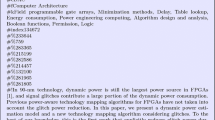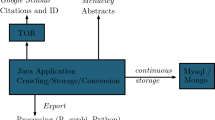Abstract
This study explores interdisciplinarity evolution of Biochemistry and Molecular Biology (BMB) over a one-hundred-year period on several fronts, namely: change in interdisciplinarity, identification of core disciplines, disciplinary emergence, and potential discipline detection, in order to assess the evolution of interdisciplinarity over time. Science overlay maps and a StreamGraph were used to visualize interdisciplinary evolution. Our study confirms that interdisciplinarity evolves mainly from neighbouring fields to distant cognitive areas and provides evidence of an increasing tendency of BMB researchers to cite literature from other disciplines. Additionally, from our results, we can see that the top potential interdisciplinary relations belong to distant disciplines of BMB; their share of references is small, but is increasing markedly. On the whole, these results confirm the dynamic nature of interdisciplinary relations, and suggest that current scientific problems are increasingly addressed using knowledge from a wide variety of disciplines.









Similar content being viewed by others
Notes
Due to the fact that BMB accounts for a large proportion of the references it makes the StreamGraph displays all core discipline except for BMB as it would occupy a large space and squeeze other core disciplines’ space in the map.
Molecular Biology could be regarded as being part of Biochemistry. After the publication of the double-helix structure of DNA in 1953, research concerning DNA in Biochemistry is usually called Molecular Biology.
References
Abramo, G., D’Angelo, C. A., & Di Costa, F. (2012). Identifying interdisciplinarity through the disciplinary classification of coauthors of scientific publications. Journal of the American Society for Information Science and Technology, 63(11), 2206–2222.
Adams, J., Jackson, L., & Marshall, S. (2007). Bibliometric analysis of interdisciplinary research. Report to the Higher Education Funding Council for England. http://webarchive.nationalarchives.gov.uk/20100202100434/http:/hefce.ac.uk/pubs/rdreports/2007/rd19_07/.
Berg, J., & Wagner-Döbler, R. (1996). A multidimensional analysis of scientific dynamics. Part I. Case studies of mathematical logic in the 20th century. Scientometrics, 35(3), 321–346.
Bordons, M., Zulueta, M. A., Romero, F., & Barrigón, S. (1999). Measuring interdisciplinary collaboration within a university: The effects of the multidisciplinary research programme. Scientometrics, 46(3), 383–398.
Buter, R. K., Noyons, E. C., & van Raan, A. F. J. (2011). Searching for converging research using field to field citations. Scientometrics, 86(2), 325–338.
Byron, L., & Wattenberg, M. (2008). Stacked Graphs: Geometry and aesthetics. IEEE Transactions on Visualization and Computer Graphics, 14(6), 1245–1252.
Carley, S., & Porter, A. L. (2012). A forward diversity index. Scientometrics, 90(2), 407–427.
Chang, Y. W., & Huang, M. H. (2012). A study of the evolution of interdisciplinarity in library and information science: Using three bibliometric methods. Journal of the American Society for Information Science and Technology, 63(1), 22–33.
Garner, J., Porter, A. L., Borrego, M., Tran, E., & Teutonico, R. (2013). Facilitating social and natural science cross-disciplinarity: Assessing the human and social dynamics program. Research Evaluation, 22(2), 134–144.
Hamilton, K. S. (2003). Subfield and level classification of journals. CHI No. 2012-R, CHI Research Inc.
Havre, S., Hetzler, B., & Nowell, L. (2000). ThemeRiver: Visualizing theme changes over time. In: Proceedings of the IEEE Symposium on Information Vizualization 2000, IEEE Computer Society: 115.
Hinze, S. (1994). Bibliographical cartography of an emerging interdisciplinary discipline: The case of bioelectronics. Scientometrics, 29(3), 353–376.
Jahn, T., Bergmann, M., & Keil, F. (2012). Transdisciplinarity: Between mainstreaming and marginalization. Ecological Economics, 79, 1–10.
Klavans, R., & Boyack, K. W. (2009). Toward a consensus map of science. Journal of the American Society for Information Science and Technology, 60(3), 455–476.
Kohler, R. E. (1982). From medical chemistry to biochemistry: The making of a biomedical discipline. New York: Cambridge University Press.
Larivière, V., Archambault, É., & Gingras, Y. (2008). Long-term variations in the aging of scientific literature: From exponential growth to steady-state science (1900–2004). Journal of the American Society for Information Science and Technology, 59(2), 288–296.
Larivière, V., & Gingras, Y. (2014). Measuring interdisciplinarity. In B. Cronin & C. Sugimoto (Eds.), Beyond bibliometrics: Harnessing multidimensional indicators of scholarly impact (pp. 187–200). Cambridge: Mass: MIT Press.
Le Pair, C. (1980). Switching between academic disciplines in universities in the Netherlands. Scientometrics, 2(3), 177–191.
Lee, E. S., McDonald, D. W., Anderson, N., & Tarczy-Hornoch, P. (2009). Incorporating collaboratory concepts into informatics in support of translational interdisciplinary biomedical research. International Journal of Medical Informatics, 78(1), 10–21.
Levitt, J. M., & Thelwall, M. (2008). Is multidisciplinary research more highly cited? A macrolevel study. Journal of the American Society for Information Science and Technology, 59(12), 1973–1984.
Levitt, J. M., Thelwall, M., & Oppenheim, C. (2011). Variations between subjects in the extent to which the social sciences have become more interdisciplinary. Journal of the American Society for Information Science and Technology, 62(6), 1118–1129.
Leydesdorff, L., Carley, S., & Rafols, I. (2013). Global maps of science based on the new Web-of-Science categories. Scientometrics, 94(2), 589–593.
Morillo, F., Bordons, M., & Gómez, I. (2001). An approach to interdisciplinarity through bibliometric indicators. Scientometrics, 51(1), 203–222.
Porter, A. L., & Chubin, D. E. (1985). An indicator of cross-disciplinary research. Scientometrics, 8(3–4), 161–176.
Porter, A. L., & Rafols, I. (2009). Is science becoming more interdisciplinary? Measuring and mapping six research fields over time. Scientometrics, 81(3), 719–745.
Qiu, L. (1992). A study of interdisciplinary research collaboration. Research Evaluation, 2(3), 169–175.
Rafols, I., & Meyer, M. (2007). How cross-disciplinary is bionanotechnology? Explorations in the specialty of molecular motors. Scientometrics, 70(3), 633–650.
Rafols, I., & Meyer, M. (2010). Diversity and network coherence as indicators of interdisciplinarity: Case studies in bionanoscience. Scientometrics, 82(2), 263–287.
Rafols, I., Porter, A. L., & Leydesdorff, L. (2010). Science overlay maps: A new tool for research policy and library management. Journal of the American Society for Information Science and Technology, 61(9), 1871–1887.
Rinia, E. J., van Leeuwen, T. N., Bruins, E. E. W., van Vuren, H. G., & van Raan, A. F. J. (2002a). Measuring knowledge transfer between fields of science. Scientometrics, 54(3), 347–362.
Rinia, E. J., van Leeuwen, T. N., & van Raan, A. F. J. (2002b). Impact measures of interdisciplinary research in physics. Scientometrics, 53(2), 241–248.
Rosvall, M., & Bergstrom, C. T. (2010). Mapping change in large networks. PLoS ONE, 5(1), e8694.
Smajgl, A., & Ward, J. (2013). A framework to bridge science and policy in complex decision making arenas. Futures, 52, 52–58.
Sugimoto, C. R., Ni, C. Q., Russell, T. G., & Bychowski, B. (2011). Academic genealogy as an indicator of interdisciplinarity: An examination of dissertation networks in library and information science. Journal of the American Society for Information Science and Technology, 62(9), 1808–1828.
Tomov, D. T., & Mutafov, H. G. (1996). Comparative indicators of interdisciplinarity in modern science. Scientometrics, 37(2), 267–278.
van Eck, N. J., & Waltman, L. (2010). Software survey: VOSviewer, a computer program for bibliometric mapping. Scientometrics, 84(2), 523–538.
van Eck, N. J., Waltman, L., Dekker, R., & van den Berg, J. (2010). A comparison of two techniques for bibliometric mapping: Multidimensional scaling and VOS. Journal of the American Society for Information Science and Technology, 61(12), 2405–2416.
van Leeuwen, T., & Tijssen, R. (2000). Interdisciplinary dynamics of modern science: Analysis of cross-disciplinary citation flows. Research Evaluation, 9(3), 183–187.
Author information
Authors and Affiliations
Corresponding author
Rights and permissions
About this article
Cite this article
Chen, S., Arsenault, C., Gingras, Y. et al. Exploring the interdisciplinary evolution of a discipline: the case of Biochemistry and Molecular Biology. Scientometrics 102, 1307–1323 (2015). https://doi.org/10.1007/s11192-014-1457-6
Received:
Published:
Issue Date:
DOI: https://doi.org/10.1007/s11192-014-1457-6




